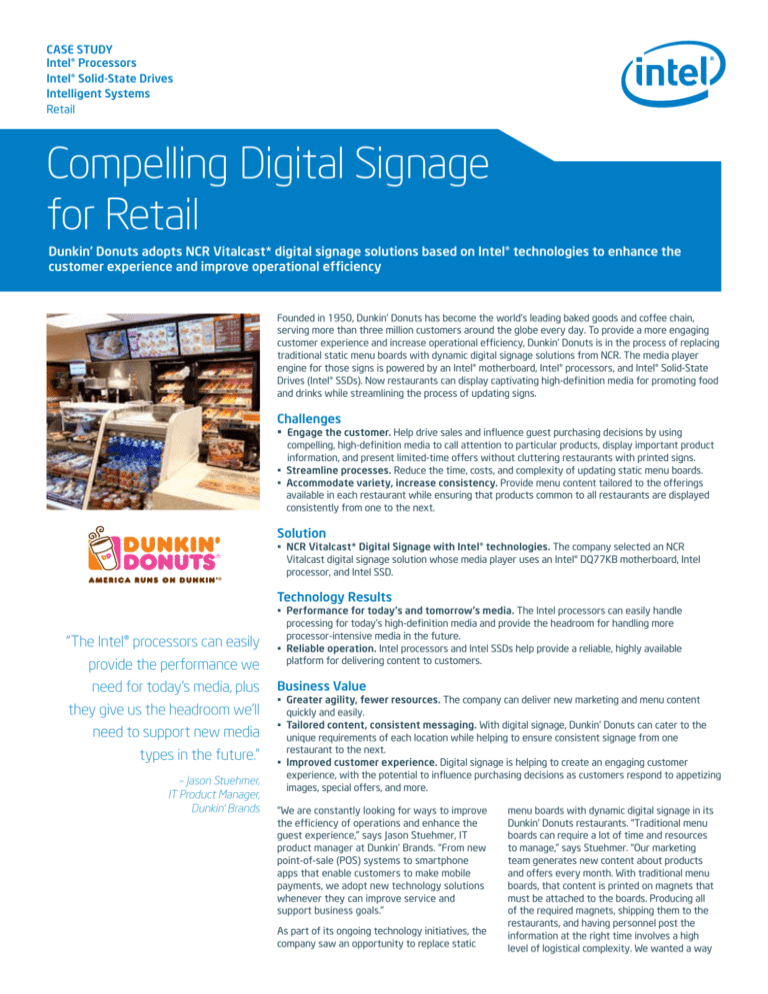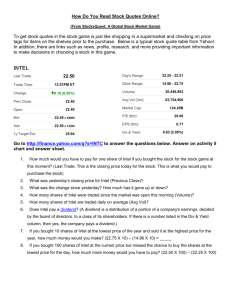
CASE STUDY
Intel® Processors
Intel® Solid-State Drives
Intelligent Systems
Retail
Compelling Digital Signage
for Retail
Dunkin’ Donuts adopts NCR Vitalcast* digital signage solutions based on Intel® technologies to enhance the
customer experience and improve operational efficiency
Founded in 1950, Dunkin’ Donuts has become the world’s leading baked goods and coffee chain,
serving more than three million customers around the globe every day. To provide a more engaging
customer experience and increase operational efficiency, Dunkin’ Donuts is in the process of replacing
traditional static menu boards with dynamic digital signage solutions from NCR. The media player
engine for those signs is powered by an Intel® motherboard, Intel® processors, and Intel® Solid-State
Drives (Intel® SSDs). Now restaurants can display captivating high-definition media for promoting food
and drinks while streamlining the process of updating signs.
Challenges
• Engage the customer. Help drive sales and influence guest purchasing decisions by using
compelling, high-definition media to call attention to particular products, display important product
information, and present limited-time offers without cluttering restaurants with printed signs.
• Streamline processes. Reduce the time, costs, and complexity of updating static menu boards.
• Accommodate variety, increase consistency. Provide menu content tailored to the offerings
available in each restaurant while ensuring that products common to all restaurants are displayed
consistently from one to the next.
Solution
• N
CR Vitalcast* Digital Signage with Intel® technologies. The company selected an NCR
Vitalcast digital signage solution whose media player uses an Intel® DQ77KB motherboard, Intel
processor, and Intel SSD.
Technology Results
“The Intel® processors can easily
provide the performance we
need for today’s media, plus
they give us the headroom we’ll
need to support new media
types in the future.”
– Jason Stuehmer,
IT Product Manager,
Dunkin’ Brands
• P
erformance for today’s and tomorrow’s media. The Intel processors can easily handle
processing for today’s high-definition media and provide the headroom for handling more
processor-intensive media in the future.
• Reliable operation. Intel processors and Intel SSDs help provide a reliable, highly available
platform for delivering content to customers.
Business Value
• G
reater agility, fewer resources. The company can deliver new marketing and menu content
quickly and easily.
• Tailored content, consistent messaging. With digital signage, Dunkin’ Donuts can cater to the
unique requirements of each location while helping to ensure consistent signage from one
restaurant to the next.
• Improved customer experience. Digital signage is helping to create an engaging customer
experience, with the potential to influence purchasing decisions as customers respond to appetizing
images, special offers, and more.
“We are constantly looking for ways to improve
the efficiency of operations and enhance the
guest experience,” says Jason Stuehmer, IT
product manager at Dunkin’ Brands. “From new
point-of-sale (POS) systems to smartphone
apps that enable customers to make mobile
payments, we adopt new technology solutions
whenever they can improve service and
support business goals.”
As part of its ongoing technology initiatives, the
company saw an opportunity to replace static
menu boards with dynamic digital signage in its
Dunkin’ Donuts restaurants. “Traditional menu
boards can require a lot of time and resources
to manage,” says Stuehmer. “Our marketing
team generates new content about products
and offers every month. With traditional menu
boards, that content is printed on magnets that
must be attached to the boards. Producing all
of the required magnets, shipping them to the
restaurants, and having personnel post the
information at the right time involves a high
level of logistical complexity. We wanted a way
Intel® technologies provide the robust, reliable
foundation for an in-store media solution
to streamline that process and provide a more
dynamic way to update information.”
Balancing the need for consistent messaging
with the unique requirements of each restaurant
was also difficult. “Not all restaurants sell all of
the same products, so we have to tailor menu
content,” says Stuehmer. “Of course, when they
do have products and offers in common, we
want to be sure that there is consistency in how
information is presented from one restaurant to
the next. Accomplishing these goals with static
boards is difficult.”
Beyond improving efficiency, the company
wanted signs that could enhance the customer
experience. “We want to present enticing,
compelling media that will highlight new
products, remind customers of existing products,
introduce limited-time offers, and more,” says
Stuehmer. “The goals were to provide that
compelling media reliably and without all
of the clutter that might result from using
physical signs.”
Selecting an NCR Solution Based on
Intel Technologies
After evaluating a number of digital signage
solutions, Stuehmer’s team selected NCR
Vitalcast digital signage, which includes digital
screens plus a media player. The media player
runs NCR Vitalcast content management
software on the Microsoft POSReady* 7
operating system. “The NCR Vitalcast solution
offered the best combination of functionality,
performance, reliability, and ongoing support,”
says Stuehmer.
The media player uses an Intel processor, an
Intel motherboard, and an Intel SSD to deliver
high-definition media to the screens. “We need
hardware components that are robust and
reliable, and can stand up to the demands of a
restaurant environment,” says Stuehmer. “We
selected a media player based on components
from Intel because we knew they would live up
to the high standards of the Intel brand.”
The Intel processors help the company maximize
the system’s longevity. “We wanted a media
player that could last five years,” says Stuehmer.
“Over that time, the types of media that we
play might change dramatically—for example,
we might require different, more processorintensive video decoding in the future. The Intel
processors can easily provide the performance
we need for today’s media, plus they give us
the headroom we’ll need to support new media
types in the future.”
The Intel SSDs contribute to that strong
media performance while also helping to
reduce downtime. “If a problem arises, a
restaurant manager might need to reboot the
media player,” says Stuehmer. “The Intel SSDs
let us reboot systems and start accessing
media again much faster than if we were
using traditional drives.”
Enhancing the Customer Experience
The digital menu boards have been very well
received by franchisees. After demonstrating
the new digital boards to franchise owners
across the United States and presenting the
business case for moving to digital signage,
Stuehmer’s team has seen widespread
adoption. “Approximately 2,000 restaurants
have deployed the solution in the last year
alone,” says Stuehmer. “Franchisees see
how this can help improve the customer
experience while improving the operational
efficiency of updating the menu boards.”
The digital systems have won over customers
as well. “On satisfaction surveys, many of our
customers have commented positively about the
digital menu boards,” says Stuehmer. “We are
able to present enticing images, promotions, and
information without an excess of printed signs.”
Using a digital system helps accommodate
variation among products from one location
to the next while also ensuring consistency of
displays across restaurants. “We can be sure
that customers will see only the products that
are available in the restaurant they’re currently
in,” says Stuehmer. “At the same time, we know
that customers can find what they want quickly,
no matter which location they are visiting.”
Improving Operational Efficiency
Using a digital system helps create a much
more efficient organization. “With the digital
system, we can eliminate that time- and
labor-intensive process of printing, shipping,
and placing magnets on a static board,” says
Stuehmer. “We simply push digital content to
store media players from a centralized location.
We can save time and money.”
Lessons Learned
Aligning multiple business units was crucial
to successfully implementing digital signage.
“Our process for providing and updating the
content for in-store menu boards affects
numerous business groups,” says Jason
Stuehmer, IT product manager at Dunkin’
Brands. “We had to make sure each group
understood how the process is changing
as we move to digital signage so we can
consistently deliver the content that the
restaurants need, when they need it.”
Making pricing changes is simpler too. “By integrating
the digital menu boards with the POS system,
restaurant managers can seamlessly update pricing
in one place and have it appear everywhere within
just a few minutes,” says Stuehmer. “We have
eliminated the extra time and potential errors of a
manual process.”
Importantly, the digital process also enables
greater agility. “We can introduce new promotions
or make any other last-minute changes when
necessary while still adhering to our marketing
schedule,” says Stuehmer. “Those fast changes
really aren’t feasible with the static menu board.”
Delivering Outstanding Performance
and Reliability
Equipped with Intel technologies, the media
players provide the robust, reliable experience
the company requires for its restaurants. “The
solution is performing really well,” says Stuehmer.
“The Intel components deliver the processing
performance we need to deliver captivating media
and the reliability to minimize downtime. The
solution is definitely living up to our expectations.”
Looking Ahead
Beyond deploying digital menu boards in additional
restaurants, the company is considering expanding
the use of the systems in restaurants and
investigating Intel® vPro™ technology as a way
to enable remote system management. “Several
restaurants have suggested integrating digital
signage as part of their drive-through service. In
the long term, we’re also considering analyzing
customer behavior to determine which digital
content delivers the best retail results,” says
Stuehmer. “By selecting systems built on Intel
technologies, we know we have a solid solution
that will continue to support our business and
technical goals for some time to come.”
Find the solution that’s right for your
organization. Contact your Intel representative,
visit Intel’s Business Success Stories for IT
Managers, or explore the Intel.com IT Center.
This document and the information given are for the convenience of Intel’s customer base and are provided “AS IS” WITH NO WARRANTIES WHATSOEVER, EXPRESS OR IMPLIED, INCLUDING ANY IMPLIED WARRANTY OF
MERCHANTABILITY, FITNESS FOR A PARTICULAR PURPOSE, AND NONINFRINGEMENT OF INTELLECTUAL PROPERTY RIGHTS. Receipt or possession of this document does not grant any license to any of the intellectual property
described, displayed, or contained herein. Intel® products are not intended for use in medical, lifesaving, life-sustaining, critical control, or safety systems, or in nuclear facility applications.
Software and workloads used in performance tests may have been optimized for performance only on Intel microprocessors. Performance tests, such as SYSmark and MobileMark, are measured using specific computer systems, components,
software, operations, and functions. Any change to any of those factors may cause the results to vary. You should consult other information and performance tests to assist you in fully evaluating your contemplated purchases, including the
performance of that product when combined with other products. For more information go to http://www.intel.com/performance
Intel does not control or audit the design or implementation of third-party benchmark data or Web sites referenced in this document. Intel encourages all of its customers to visit the referenced Web sites or others where similar performance
benchmark data are reported and confirm whether the referenced benchmark data are accurate and reflect performance of systems available for purchase.
Intel® vPro™ Technology is sophisticated and requires setup and activation. Availability of features and results will depend upon the setup and configuration of your hardware, software, and IT environment. To learn more, visit
http://www.intel.com/technology/vpro.
© 2014, Intel Corporation. All rights reserved. Intel, the Intel logo, and Intel vPro are trademarks of Intel Corporation in the U.S. and other countries.
* Other names and brands may be claimed as the property of others.
Printed in USA
0314/LJ/TDA/XX/PDF
Please Recycle
329983-001US








